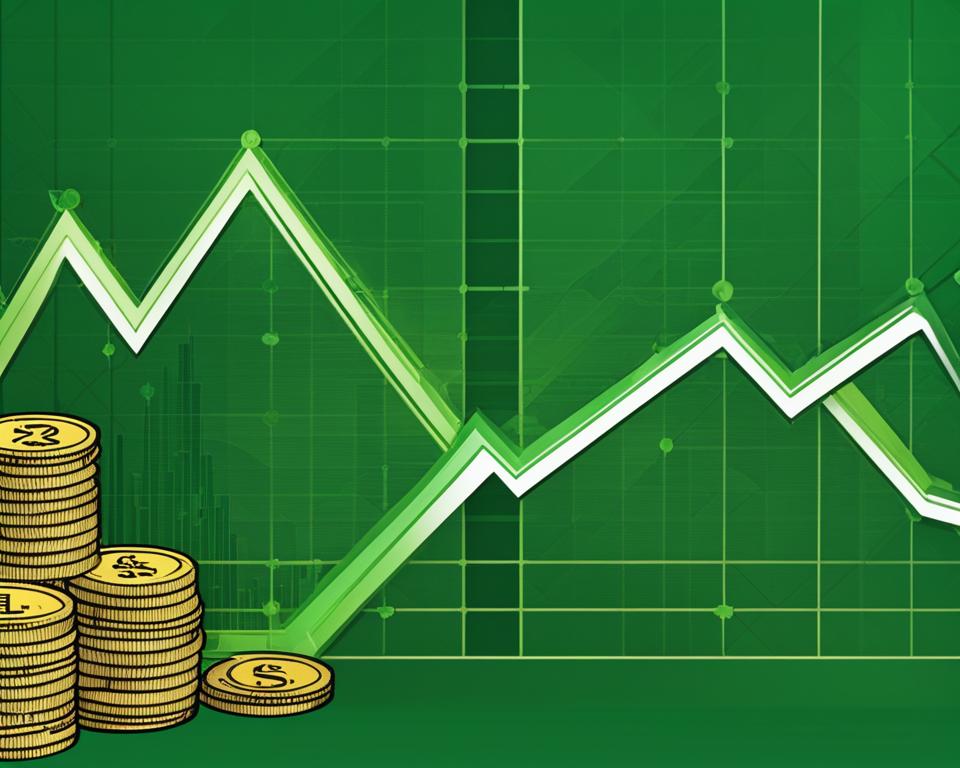As you set your sights on the investment horizon, understanding the dividend trends and analyst forecasts is essential to crafting a portfolio poised for investment growth. The market whispers of last year’s tech stock rally have not muffled the steady drumbeat of dividend-rich equities, which continue to endear themselves to investors. B. Riley Wealth’s very own Art Hogan champions the S&P 500 as your compass in navigating the complex investment climate. But there’s much more to the story than just broad market indices.
An unwavering beacon in the ever-shifting seas of stock choices, dividend stocks have consistently offered the twin lures of resilience and return. The enviable trajectory of the S&P 500 High Dividend Growth Index is a testament to this, with a robust dividend growth rate that not only weathers the storms but thrives amidst them — a testament to the enduring allure of savvy, dividend-centric investing.
Key Takeaways
- Diversify your portfolio with dividend stocks to counterbalance market unpredictability.
- Lean on the S&P 500 for a proven path through diverse market climates.
- Keep an eye on the S&P 500 High Dividend Growth Index which has outshone the overall S&P 500 with impressive returns.
- Explore the dividend growth rate as an indicator of a company’s stability and commitment to investors.
- Consider analyst forecasts to discern the dividend trends that could shape your investment growth in the upcoming year.
- Revisit your investment strategy in light of the projections for dividend stocks, as these could redefine the investment landscape ahead.
Understanding Dividend Trends: A Recap of the Past Year
In retrospect, the fiscal easel of 2023 vividly paints a mixed palette highlighting the gravitational pull of market performance on investment yields. Dividend aficionados have borne witness to this transformative narrative, one that course-corrects as it encounters economic headwinds and technological advancements. To aid your understanding of the shifts and strategies that may guide your own investment saga, let us delve into the recent past’s dividend yield landscapes.
The Impact of 2023’s Market Performance on Dividend Payouts
Last year’s stock market volatility whispered caution into the chambers of dividend policy makers, beckoning a reassessment of the dividend payout ratio. This balancing act of profit-sharing sustained investor appetites for consistent dividends amidst a backdrop of burgeoning tech investment enthusiasm. To tether to tranquility in market tempests, these ratios served as a keel, underscoring corporate stability and resolve.
Analysis of 2023’s Dividend Yield Fluctuations and Trends
Diligent dividend yield analysis served as a lighthouse for navigating the choppy tides of market yield fluctuations. Through analyzing yields, we gleaned insights into the perennial resilience of dividends. With an astute eye on such data subsets, income-focused investors could prioritize their allocations in lesser-known harbors that promised shelter and sustenance.
S&P 500 High Dividend Growth Index Review
Yet amidst this cornucopia of dividend-dishing companies, the S&P 500 High Dividend Growth Index stood as a sentinel. Its constituents – those who’ve unceasingly elevated their dividend offerings for no less than a quintet of years – delivered not just stability, but growth, trumping the benchmark S&P 500 with enviable alacrity. Your keen attention to this index could well align your portfolio with the upper echelons of market performance.
| Year | Average Annual Return | Dividend Growth Rate | Yield |
|---|---|---|---|
| Previous Years (2010-2022) | 11.94% | 13.8% | Higher than S&P 500 |
| 2023 | Varies with Market Performance | Data Pending Year-End | Analyzed for Trends |
Indeed, as you reflect upon the dividends of yesteryear and those on the event horizon, brace yourself for what unfolds next in the monetary odyssey that awaits. Your savvy will be discerned not just in knowledge but in the artful application of these revelations to your fiscal patchwork.
Dividend Trends and Analyst Predictions for the Upcoming Year
As you explore dividend investing strategies for the coming year, it’s vital to heed the expert guidance echoing from Wall Street. Analyst predictions illuminate a trajectory that could very well redefine your portfolio’s performance. They predict a renaissance for dividend equities as potential interest rate cuts in 2024 entice capital migration from money market funds. This anticipated shift spotlights dividend stocks as potentially lucrative footholds in the investment landscape.
Top figures from the respected analytics platform TipRanks have earmarked a roster of stocks, distinguished not only by their formidable dividend histories but also by their prognosis for future growth, as prime candidates for those in pursuit of attractive, stable dividend yields. In their view, certain corporations stand out, such as Albemarle Corporation, a beacon of consistency, having escalated its dividends annually for nearly three decades. Similarly, Cheniere Energy garners attention, having instituted a dividend policy in 2021, each payment fortifying its commitment to shareholder returns.
Let’s take a moment to review the solid foundations and forward-looking anticipations that carve out the promising narrative for dividend trends in 2024:
- Dividend investing strategies grounded in companies with robust dividend histories and growth trajectories.
- Interest rate predictions and economic forecasts shaping the prospects for dividend stocks.
- Analyst-endorsed stocks characterized by sustained and growing dividends, heralding them as prudent inclusions for income-focused portfolios.
This shift towards dividend abundance is not merely a speculative venture; it is underpinned by methodical analysis from industry experts deeply acquainted with market oscillations. They proffer a clear signal: in the approaching fiscal year, dividend investing could very well become a cornerstone strategy for prudent investors proactively navigating the economic tides.
Exploring the Appeal of Dividend Stocks in a Fluctuating Economy
In the face of a fluctuating economy, dividend stocks are emerging as a sturdy bastion for investors, particularly with the impending likelihood of interest rate cuts in 2024. The shifting economic tides lend credence to the theory that such stocks are not merely safe havens; they are also vessels of potential growth and stable income. With eyes on the market’s horizon, let’s dive into why these might be seen as a beacon for your investments.
Interest Rate Cuts: A Potential Boon for Dividend Stocks?
Anticipated interest rate cuts come as music to the ears of those vested in dividend aristocrats—those paragons of the corporate world that boast a history of raising dividends year-over-year. The potential easing of interest rates is projected to pivot the spotlight on these stocks due to their reputations for delivering consistent returns regardless of economic cycles. This trend, should it arise, could surge dividends to the forefront of investment strategies, making them particularly alluring in your portfolio.
Dividend Stocks Versus Money Market Funds in 2024
A paradigm shift might be underway as investors, who have traditionally sought shelter in the predictable but currently low-yield money market funds, begin to redirect their capital. In anticipation of an interest rate descent, analysts are forecasting that dividend stocks will shine as attractively yielding alternatives. Their longstanding ability to sail through the volatility of a fluctuating economy makes them strong candidates for those seeking to anchor their investments in something more than mere stability.
- Navigating the disparate currents of a fluctuating economy with seasoned dividend payers.
- Balancing the risk versus reward scale, as expectations of interest rate cuts recalibrate investment preferences.
- Charting a course towards dividend aristocrats, where history informs a likely future of steady gains.
- Comparing the steadfastness of dividend stocks against the ebbing appeal of money market funds.
Your fiscal map in 2024 might perhaps be best drawn with these dividend-bearing stocks in mind, especially if the predicted interest rate reductions come to pass. Such a turn of events would not only brighten the prospects of dividend stocks but could make them the leading stars in a new investment constellation.
Insights from Experts: Dividend Yield Analysis for Strategic Investing
When it comes to strategic investing, savvy investors know that not all dividends are created equal. The allure of a high dividend yield might grab headlines, but insights from financial experts point towards a more nuanced approach – dividend yield analysis. This strategy calls for a deep dive, not just into current yields, but also into the potential for dividend growth, a critical factor that could compound investment returns over time.
Consider the wisdom of looking beyond the allure of immediate yields; rather, a focus on the dividend growth rate may yield far more fruit in the long term. For instance, historical data from the Russell 1000 Index reveal that stocks with a consistent record of increasing dividends are likely to offer better performance with less volatility when compared against the broader benchmark – a trend that has held from 1985 to 2022.
To equip you with the best possible approach for dividend yield analysis, let’s consider a hypothetical table that underscores the importance of the dividend growth rate:
| Year | Dividend Yield | Dividend Growth Rate | Stock Performance |
|---|---|---|---|
| 2021 | 3% | 5% | Stable |
| 2022 | 3.5% | 7% | Positive |
| 2023 | 4% | 9% | Strong |
The beauty of such an analytical approach lies in its ability to forecast trends and align investments with those companies that boast not just stability, but a commitment to growth. This is the essence of strategic investing, where every decision is taken not on a whim but is backed by expert insights and a thorough analysis of dividend trends.
- Assess a stock’s historical dividend increases to gauge its financial health and growth commitment.
- Use the dividend growth rate as a predictor for the company’s future performance.
- Employ dividend yield analysis as a part of a comprehensive investment strategy.
Through the careful vetting of dividend yields and growth rates, you can sharpen your investment strategy, setting your sights on generating steady income while capitalizing on the potential for long-term growth. As you chart your course through the investing seas, let the insights from the experts guide you towards calmer waters and more prosperous lands.
The Rise of Dividend Aristocrats and What It Signals
As we explore the realm of dividend-paying stocks, a particular group stands out for their exceptional track record: the dividend aristocrats. Notable for their reliability and commitment to rewarding investors, companies like Johnson & Johnson, Procter & Gamble, and AbbVie lead as exemplars within this esteemed category. What sets these companies apart is not just their history of providing dividends but their unwavering practice of increasing payouts to shareholders, symbolizing robust corporate health and promising investment growth.
Before we define the criteria that earmark these companies as aristocrats of the dividend world, let’s take a moment to understand why their ascent is a signal of more than just financial prosperity—it is a beacon for investors in search of stable and growing revenue streams in their investment portfolios.
Johnson & Johnson, Procter & Gamble, and AbbVie as Role Models
Why do Johnson & Johnson, Procter & Gamble, and AbbVie stand as paragons among dividend-paying stocks? Each of these companies has not just met but surpassed the quintessential expectation of stability; they have delivered consistent, incrementally increasing dividends over an impressive span of years. This demonstrates a level of financial health and sustainability that is nothing short of extraordinary in the business world.
- Johnson & Johnson: A healthcare giant with a dividend history that investors have come to depend on year after year.
- Procter & Gamble: From home goods to personal care, this company’s expanding dividends mirror its market endurance and adaptability.
- AbbVie: In the competitive pharmaceutical industry, AbbVie’s rising dividends highlight its strategic innovation and growth.
Criteria Defining Dividend Aristocrats
To qualify as a dividend aristocrat, a company must adhere to a set of stringent criteria. Primarily, it must have a consecutive record of increasing dividends for a minimum period – often considered to be at least 25 years. This criterion is not a mere threshold; it represents a commitment to delivering value back to shareholders consistently, thereby building trust and a formidable reputation in the investment community.
Here’s a glance at what it takes to be counted among the prestigious circle of dividend aristocrats:
| Criteria | Description |
|---|---|
| Consecutive Increases | Minimum of 25 years of consecutive dividend increases |
| Market Presence | Noteworthy brand recognition and market share |
| Financial Health | Stable financial metrics and favorable growth outlook |
| Shareholder Focus | Consistent returns and value-sharing through dividends |
In summary, the rise of dividend aristocrats, such as Johnson & Johnson, Procter & Gamble, and AbbVie, reveals more than just a trend in investment growth. It signifies a deep-rooted assurance in the financial markets—a sign that there are still companies out there that investors can rely on for not just good, but ever-improving returns.
How the Dividend Growth Rate Influences Long-Term Investments
When eyeing the horizon of long-term investments, shareholders often seek a beacon of reliability within their portfolios—a guiding light in the form of dividends. Beyond the passive income dividends provide, there’s an essential metric that savvy investors scrutinize: the dividend growth rate. Like the steady ascent of a lighthouse beam piercing through fog, a company’s rising dividend growth rate signals its resilience and capacity for sustained prosperity.
The case for focusing on the dividend growth rate rests on compelling evidence. According to research by T. Rowe Price, companies boasting a consistent increase in dividends have historically outpaced their market peers, offering not just better performance but also reduced volatility. This trait alone marks them as a cornerstone of any long-term investment strategy determined to weather the capricious nature of the markets.
To truly harness the power of dividends, investors adopt a methodology akin to farming, where reinvesting the dividend “crop” can yield an even more bountiful harvest. The strategy of compounding—reapplied rather than released dividends—catapults the potential for portfolio growth, turning a trickle into a stream through the power of accumulation.

So, if you’re charting a course through the fiscal seas, prime your sails with dividend trends. As your portfolio embarks on its journey, consider the dividend growth rate not just as a snapshot of current health, but as a trajectory pointing towards future wealth. Earmarking stocks with a robust history of dividend growth may prove to be essential in your investment odyssey. Your long-term investment strategy, bolstered by these lighthouses on the shores of commerce, could maneuver past the treacherous shallows of short-termism into the deep, open waters of financial security.
- Seek out companies with a strong history of dividend growth rate as an indicator of their commitment to shareholder prosperity.
- Factor in dividend trends when weighing long-term investments for a diverse and balanced portfolio.
- Consider the strategy of reinvesting dividends to exploit the potential of compounding, accelerating your investment journey.
Let the insight into dividend trends light your path, and with it, illuminate the potential for a thriving investment portfolio that stands the test of time.
Maximizing Returns with Top Dividend Stocks
When it comes to maximizing your portfolio’s returns, top dividend stocks stand out. These equities offer not only a passive income stream but also hold the promise of capital appreciation. Distinguishing themselves through consistent performance, they are the keystones in a strategy aiming to balance yield with growth. Let’s delve into the insights from Wall Street analysts who have their fingers on the pulse of dividend stocks with significant upside potential.
Wall Street Analysts Spotlight on Realty Income and Kraft Heinz
Two giants that have consistently caught the attention of market experts are Realty Income and Kraft Heinz. Realty Income, a stalwart in the REIT panorama, is lauded for its dependable monthly dividends—backed by an extensive portfolio of properties under long-term net leases, which translate to stable cash flow. On the other hand, Kraft Heinz, a behemoth in the food and beverage sector, promises investors a tempting dividend yield. Moreover, a comprehensive share repurchase plan underlines their commitment to enhancing shareholder value.
What sets these companies apart? Their dividend histories and growth prospects are the foundation of an investment with high upside potential. This is precisely the kind of strategic opportunity that can contribute to maximizing returns in your dividend-focused portfolio.
Evaluating Dividend Stocks with High Upside Potential
Finding the right dividend stocks involves looking for those with a bright horizon—companies whose upcoming years could unfold with significant growth in dividends and share prices. It’s a quest for the balance between present security and future expansion, appealing to both the conservative and the optimist in every investor.
- Seek out established companies with a track record for raising dividends.
- Consider the projected future earnings and growth strategies that may influence dividend policies.
- Review analysts’ target price upgrades to measure the expected upside potential.
- Analyze market conditions that may impact specific industries known for top dividend payouts.
For your portfolio, investing in companies like Realty Income and Kraft Heinz might not just be about the attractive yields today, but also about the potential for return maximization tomorrow.
Dividend Investing Strategies for the Modern Portfolio
As an investor, anchoring your modern portfolio with strategic dividend investing strategies can be a transformative move. Dividend investing is more than just the pursuit of current income; it’s about the long-term ambition to grow capital while receiving periodic payouts. In the ever-evolving financial landscape, it becomes crucial to understand the dividend growth rate, as this metric often reflects the underlying health and growth prospects of a company.
The essence of a solid dividend investing strategy lies in identifying high-dividend paying stocks that are not only industry leaders but also have a substantial history of increasing their dividends. By focusing on the dividend growth rate, you can spot companies that are predicted to sustain or increase their dividend distributions, which can be pivotal in an inflation-prone economy. Therefore, a balanced approach that looks for yield today and growth for tomorrow can be a prudent path for your portfolio.
When you’re ready to integrate dividend-paying stocks into your portfolio, consider these foundational strategies:
- Analyze the historical dividend patterns and payout consistency.
- Assess the dividend policies and financial stability of different companies.
- Scrutinize dividend growth rates for signs of sustainable corporate profitability and shareholder commitment.
- Evaluate industry stability and market position to determine the long-term viability of the dividends offered.
- Balance your portfolio with a mix of high-yield and growth-oriented dividend stocks for a diversified investment approach.
While you build your dividend-powered portfolio, also remember to factor in industry trends and economic indicators. Doing so can ensure your investments are aligning with sectors that are positioned to thrive, thereby supporting a robust flow of dividends. For a visual representation of how dividend growth can impact your investment outcome, consider the following exemplary table:
| Year | Dividend Yield | Dividend Growth Rate | Impact on Portfolio |
|---|---|---|---|
| 2021 | 4% | 6% | Steady Income |
| 2022 | 4.5% | 8% | Increased Income |
| 2023 | 5% | 10% | Enhanced Growth |
Beyond the current yield, it’s the acceleration of dividend growth that can give your modern portfolio the edge. This growth not only suggests a company is performing well but also that it is confident about its future prospects—making it potentially a more secure and lucrative investment.
Finally, integrating these strategies into your portfolio requires a balance between diligence and vision. It’s not just about capturing high yields today, but also about anticipating and benefiting from future growth. Financial goals are as unique as the investors who set them, and with the right dividend investing strategies, you can craft a portfolio that resonates with your aspirations.
Potential Impact of Inflation on Dividend Stocks
As an investor, you’re likely aware that inflation can significantly affect your portfolio’s purchasing power. When analyzing your dividend stock options, it’s important to consider how well these investments can serve as a financial bulwark against this persistent economic challenge.

Dividend growth, a crucial metric for dividend stocks, often acts as a hedge against inflation. By selecting companies that historically deliver increasing dividends, you equip your portfolio with an innate defense against the eroding influence of rising inflation rates.
Dividend Growth as a Hedge Against Inflation
Inflation impact on investment returns is unavoidable but not unassailable. Dividend stocks, especially those with a history of dividend yield increases, have historically provided investors with a measure of protection by potentially outpacing inflation rates. Securities like those included in the S&P 500 High Dividend Growth Index command attention as they demonstrate capacity to enhance their payouts in response to inflation, thus maintaining—or even enhancing—the real value of the income they provide.
Comparing Inflation Rates with Dividend Yield Increases
A close examination of inflation rates alongside dividend yield increases reveals that stocks within certain indices have managed to not just keep pace with inflation, but exceed it. For example, historical data from the S&P 500 High Dividend Growth Index underscores such stocks’ aptitude to function as an effective dividend hedge in your portfolio composition.
- Historical evidence shows that strategically increasing dividends can buffer the inflation impact on investment returns.
- Assessing the dividend yield increases alongside prevailing inflation rates can offer insights into the defensive posture of your dividend stocks.
- Choosing dividend stocks that are part of the S&P 500 High Dividend Growth Index could lend your portfolio resilience against inflationary pressures.
The prudent investor looks beyond current yields to the growth trends that can redefine an investment’s future value. Such strategic foresight into dividend stocks can be a strong play in fortifying your fiscal future against inflation’s tide.
Utilizing a Dividend Stock Screener: Tips and Tricks
Are you looking for an efficient way to sift through the vast sea of investment options and pinpoint the top dividend stocks? A dividend stock screener is your indispensable ally. This powerful tool can drastically streamline your search and can be tailored to your specific investment criteria, including preferred yield percentages, dividend payout ratios, and growth potentials.
Navigating a stock screener might seem overwhelming at first, but with these tips and tricks, you’ll be identifying potentially lucrative dividend stocks in no time.
- Yield Thresholds: Establish minimum yield thresholds to filter out stocks that don’t meet your income goals.
- Dividend Payout Ratio: Set a range for the dividend payout ratio that suggests sustainability. A too-high ratio could signal a future dividend cut, so seek that balance.
- Growth Potential: Factor in dividend growth rates to identify companies with a record of increasing their payouts.
- Consistency Counts: Look for stocks with a consistent history of paying dividends. Reliability is key in long-term investment.
- Industry Selection: Apply industry filters to home in on sectors known for strong dividend performance.
- Market Cap Matters: Depending on your risk tolerance, you may want to include or exclude companies based on market capitalization.
Using a dividend stock screener isn’t just about applying filters. It’s about interpreting the data to understand a stock’s overall potential. Here’s an example of a screener output:
| Stock | Dividend Yield | Dividend Payout Ratio | 5-Year Growth Rate | Market Cap |
|---|---|---|---|---|
| Company A | 3.5% | 50% | 6% | $10B |
| Company B | 4.0% | 60% | 4% | $20B |
| Company C | 5.0% | 65% | 3% | $50B |
As evident in the table above, comparing different dividend stocks side by side allows an investor to make an informed choice based on their individual preferences and risk profile. In adding screens for aspects like market cap, investors can further tailor the results to ensure the best fit for their financial strategy.
Remember, the right stock screener empowers you to efficiently navigate the investment landscape, cherry-pick potential winners, and, ultimately, strive to ensure that your dividends contribute to your fiscal goals. Start screening, and you just might discover those hidden gems with a consistent track record of rewarding their shareholders handsomely.
Assessing Dividend Payout Ratios for Sustainable Dividends
As investors seek to fortify their portfolios with stocks that provide long-term dividend income, understanding the intricacies of dividend payout ratios becomes paramount. This figure is more than just a metric; it’s a window into a company’s dedication to shareholder value and its resilience amidst financial fluctuations.
Key Metrics for Evaluating Dividend Sustainability
The centerpiece of evaluating dividend sustainability lies in the dividend payout ratio, which represents the share of earnings distributed to shareholders as dividends. To consider a dividend sustainable, look not just at the current payout but at **key metrics** like historical ratios and the consistency of earnings growth. These figures, when juxtaposed, portray a clearer picture of whether a company can continue rewarding its shareholders without sacrificing its financial health.
A prudent approach involves evaluating companies with lower payout ratios, as this suggests they’re maintaining a buffer to absorb market shocks while still committing to shareholder dividends. Conversely, a high payout ratio could signal potential distress or a peak in payouts that may not be maintainable in the long term.
Why Payout Ratio Matters for Dividend Health
Why put such an emphasis on dividend payout ratios? Because they are a direct reflection of **dividend health**. A company with a payout ratio that exceeds 100% is red-flagged, indicating it is paying more in dividends than it is earning, a practice that is unsustainable over time. Wise investors target **sustainable dividends** supported by solid payout ratios, indicative of a company’s ability to grow dividends congruent with its earnings.
Incorporating dividend payout ratios and other **key metrics** into your analysis toolkit can amplify your capacity to detect **sustainable dividends**. With an eye for **dividend health**, you’re better equipped to weave a fabric of reliable income streams into your investment tapestry, capable of weathering the caprices of economic cycles.
Industry Perspectives: The Most Promising Sectors for Dividends
When you look at the landscape of dividend investing, certain sectors stand out for their ability to offer reliable and growing dividends. Industry analysts have their radar locked on a few promising sectors that could serve as the cornerstones for your investment portfolio. Let’s explore why these areas are earning such a spotlight and how they can contribute to your dividend growth outlook.
At the forefront of these sectors are the telecommunications giants. Take Verizon, for example, with its consistent dividend growth and attractive yield, it exemplifies the stability and resilience that are hallmarks of a top dividend stock. In the realm of telecommunications, companies like Verizon have been able to leverage their extensive infrastructure and large customer bases to generate steady cash flows, which in turn support their generous dividend payouts.

Moving to energy and midstream services, we notice a distinct pattern of high yields. Companies such as MPLX LP and Enterprise Products Partners are not only highlighted for their current dividend yields but also for their potential to sustain and increase these dividends over time. Their financial strength, rooted in the essential nature of their services, ensures a level of demand that can support long-term dividend programs. This makes them a promising choice for dividend investors.
Let’s dive into the numbers to solidify our understanding of why these sectors are considered promising for those pursuing dividend investing:
| Company | Sector | Current Dividend Yield | 5-Year Average Dividend Growth Rate |
|---|---|---|---|
| Verizon Communications Inc. (VZ) | Telecommunications | 6.7% | 2.5% |
| Enterprise Products Partners L.P. (EPD) | Energy/Midstream Services | 8.0% | 2.7% |
| MPLX LP (MPLX) | Energy/Midstream Services | 9.0% | 6.2% |
As you navigate the options within these industry perspectives, consider the impact of stability and growth potential on your long-term investment outcomes. In the world of dividend investing, it’s often these steadfast and forward-looking companies that can provide a bedrock for your portfolio’s growth and income objectives.
Your approach to building a robust dividend-paying portfolio will largely depend on identifying and investing in these top-performing sectors. Whether you’re new to dividend investing or looking to enhance your existing strategy, keeping an eye on these industries is essential. Starting with these strong contenders could lead you down a path of lucrative industry perspectives and assist you in reaching your financial aspirations.
Expert Opinions: The Key Role of Dividend Stocks in Retirement Planning
When it comes to retirement planning, the chorus of expert opinions is harmonious; dividend stocks are a pivotal player. As the stage of regular income draws its curtain post-retirement, these stocks step into the limelight, offering retirees a degree of predictability and security within their investment portfolios. Let’s explore why financial analysts encourage incorporating dividend income into a well-rounded retirement strategy.
The Importance of Dividend Income for Retirees
Imagine your retirement income as a puzzle, with each piece contributing to the complete financial picture. In this scenario, dividend income is akin to a corner piece—essential and foundational. Dividend stocks can provide a stream of income that has the potential to grow over time, which is invaluable for managing living expenses against the backdrop of inflation. Moreover, this kind of income brings the added benefit of often being taxed at a lower rate compared to other forms of income, thereby preserving more of your hard-earned money during retirement years.
Financial Analysts’ Take on Dividends as a Retirement Strategy
Turning to the sage advice of financial analysts, there’s a consensus that dividends should be a quintessential element of retirement portfolios. Reputable investment firms suggest diversifying retirement funds across various sectors known for reliable dividends. This way, retirees can enjoy the fruits of well-established companies that are historically less volatile and more likely to distribute a portion of their profits back to shareholders.
Data nestled within the reports of financial institutions depict a long-standing trend of dividend-paying stocks outperforming their non-paying counterparts over extended periods. Let’s break down some key data through a comparative table that may influence your retirement planning:
| Company Type | 5-Year Dividend Increase Rate | Yield Stability | Role in Retirement Portfolio |
|---|---|---|---|
| Dividend Growth Stocks | Positive | High | Core Holding |
| High Dividend Yield Stocks | Varies | Moderate to High | Income Generation |
| Non-Dividend Stocks | N/A | Low | Growth Potential |
Embracing the wisdom of expert opinions in retirement planning, it becomes evident that a diversified strategy incorporating dividend income can usher in peace of mind. It’s the steady pulse amid the chaotic beat of the market—put simply, a dividend-based approach in your golden years equates to a financial cushion meant to ensure the comfort and security you’ve worked toward all your life.
The Future of Dividend Trends: Technology Versus Traditional Stocks
In the intriguing landscape of investment strategies, discerning the future outlook of dividend trends requires a balanced examination of technology stocks against traditional stocks. The investment community has long favored the predictive dividends rendered by stalwarts in sectors like consumer goods, utilities, and healthcare. Meanwhile, the recent energy that technology stocks have brought to the market cannot be overlooked, presenting nuanced pathways for potential wealth growth.
As we gaze into the financial horizon, it’s evident that technology stocks have carved a significant niche, commanding superior growth rates and leading market valuations. Yet, their often negligible dividend offerings, if any, position them as less enticing for those seeking regular income streams. On the other hand, traditional stocks furnish dependable dividends, bolstering portfolios with a sense of security and predictability. This dichotomy prompts investors to ponder which route may yield them the golden fleece of investment success.
Observing these market dynamics, it becomes crucial for you to monitor shifts in industry performance, stay attuned to the impacts of regulatory changes, and remain agile amid the shifting sands of economic conditions. The power to harness the potential of both sectors lies in a portfolio that can pivot with prescience. Embracing this perspective allows for a harmonious blend of growth and income, capitalizing on the vivacity of technology and the steadfastness of traditional dividend payers.
Let’s consult a table that juxtaposes recent performance trends in both realms, offering you a clearer view as you strategize for the future:
| Stock Type | Recent Growth (Past Year) | Dividend Yield | Future Outlook |
|---|---|---|---|
| Technology Stocks | High Growth, Volatile | Generally Low or None | Growth-oriented, but uncertain dividends |
| Traditional Dividend Stocks | Steady, but Lower Growth | Higher and Predictable | Stable income, with potential for gradual growth |
The contrast in the table above serves as a lucid guide in the decision-making process. Technology stocks, heralded for their potential for rapid appreciation, may complement the slower, yet more dependable, dividend yield of traditional stocks. This symbiosis forms the bedrock of an investment approach that seeks to maximize returns while mitigating risk associated with market volatility.
Understanding the future of dividend trends necessitates that you maintain a panoramic view of the market landscape—one that incorporates a tapestry of diverse assets. As the boundaries between growth and income continue to blur, your judicious investments in both technology and traditional stocks could pave the way for a portfolio that resonates with resilience and opportunity.
Conclusion
As we wrap up our exploration, it is apparent that dividend trends, guided by insightful analyst insights, remain a significant aspect of investment strategies. Amidst last year’s turbulence, the endurance of dividend stocks stood out, their appeal unscathed by shifting economic winds. With a future outlook that hints at potential interest rate cuts, these bastions of investment strategy might once again rise to prominence, beckoning a keen focus from those looking to bolster their portfolios.
Summarizing Analyst Insights on Dividend Trends
Your journey through the insights of financial analysts has revealed a unanimous respect for dividend stocks. Despite the headwinds, the resilience of companies, particularly dividend aristocrats, continues to offer a sense of security amidst market volatility. Analyst insights stress the advantage of leveraging dividend yield analysis as a tool for strategic investments and ensuring wealth growth for the long-term investor.
The Road Ahead: What to Watch for in Dividend Trends
Looking ahead, the emergence of conducive economic conditions and an investor-friendly climate may renew vigor in the pursuit of dividend stocks. You’re encouraged to keep an eagle eye on the market, ready to pivot your investment strategies to capitalize on the proven performance of companies with a track record of dividend growth. It’s not just about immediate returns but about setting the stage for future financial success. Keep abreast of shifting market dynamics and analyst sentiments to navigate the investment opportunities that lie ahead.
FAQ
What are analysts saying about dividend trends for the upcoming year?
Analysts forecast continued resilience and attractiveness for dividend stocks in the coming year, underscoring their importance for investment growth and stability. Dividend growth rates are also expected to be a significant factor in favorable analyst forecasts for dividend trends.
How did 2023’s market performance impact dividend payouts?
The market performance in 2023 posed challenges for dividend stocks due to increased volatility and a pivot towards technology investments. However, despite these challenges, dividends have remained a reliable source of income, with companies represented in the S&P 500 High Dividend Growth Index continuing to yield strong results.
Can you explain the fluctuations and trends in the dividend yield for 2023?
Dividend yield trends for 2023 included fluctuations influenced by broader market conditions, emphasizing the importance of sustainability in dividend payouts. Analysts closely monitored indices like the S&P 500 High Dividend Growth Index to track these trend changes.
How does the S&P 500 High Dividend Growth Index review inform investors?
The S&P 500 High Dividend Growth Index provides a review of companies with a track record of at least 5 years of consistent dividend increases. Its performance, surpassing the S&P 500, informs investors about strong contenders for dividend investing and showcases the long-term advantages of focusing on dividend growth.
What are the dividend investing strategies and predictions for the next year?
Dividend investing strategies include focusing on dividend growth rates, identifying high-dividend paying stocks, and considering sustainability and growth prospects. For the upcoming year, analysts predict a favorable scenario for dividend stocks, especially with the potential for interest rate cuts in 2024.
How might interest rate cuts in 2024 benefit dividend stocks?
Interest rate cuts in 2024 are expected to shift investor attention from low-risk money market funds back to dividend-yielding equities. This can enhance the appeal of dividend stocks, making them a potentially more attractive option for income-seeking investors.
How do dividend stocks stack up against money market funds for 2024?
Dividend stocks could become more favorable compared to money market funds in 2024 if interest rates are cut, as they may offer higher yields and the potential for capital appreciation. Dividend aristocrats, in particular, with their proven track records, might draw more investor interest.
What insights do experts offer on dividend yield analysis for strategic investing?
Experts suggest conducting a thorough dividend yield analysis, considering not just the current yield but also the potential for dividend payout growth. This strategic approach helps identify stocks that provide a stable and potentially increasing source of income.
How are dividend aristocrats recognized in the investment community?
Dividend aristocrats are highly regarded in the investment community for their history of incrementally increasing dividends, reflecting financial health and a sustainable business model. They are seen as a reliable choice for investors looking for long-term stability and growth.
What role do Johnson & Johnson, Procter & Gamble, and AbbVie play as dividend aristocrats?
Johnson & Johnson, Procter & Gamble, and AbbVie serve as role models for other companies, exemplifying the strength and reliability of dividend aristocrats. Their consistent dividend increases act as a testament to their financial discipline and investor commitment.
What constitutes the dividend aristocrat criteria?
The criteria defining dividend aristocrats typically include a history of at least 25 consecutive years of dividend increases, showcasing a company’s commitment to consistent shareholder returns and signaling long-term financial stability.
Why is the dividend growth rate important for long-term investments?
The dividend growth rate is crucial as it indicates the company’s potential for profitability and sustainability, appealing to investors looking for both yield and growth. Higher dividend growth rates can also contribute to compound portfolio growth over time.
Which top dividend stocks are being spotlighted by Wall Street analysts?
Wall Street analysts have spotlighted stocks like Realty Income, known for its consistent dividends, and Kraft Heinz, with a solid dividend yield and share repurchase plan. These companies have been identified for their high upside potential and stable dividend records.
How can investors evaluate dividend stocks with high upside potential?
To evaluate dividend stocks with high upside potential, investors should review the company’s dividend history, financial stability, industry position, and potential for future earnings growth to determine the likelihood of continued dividend increases.
What are the best dividend investing strategies for today’s portfolios?
Modern dividend investing strategies involve analyzing historical dividend patterns, company dividend policies, the stability of industry sectors, and screening for stocks with robust yield and growth potential to optimize portfolio returns.
How does dividend growth help hedge against inflation?
Dividend growth can serve as a hedge against inflation by providing investors with income streams that have the potential to grow over time, often outpacing inflation rates and preserving the purchasing power of their returns.
How do dividend yield increases compare to inflation rates?
Dividend yield increases, especially from companies with a history of growing their payouts, have often surpassed long-term inflation rates, helping investors protect their income from the erosive effects of rising costs.
What are some tips for using a dividend stock screener effectively?
When using a dividend stock screener, it’s vital to set specific criteria based on desired yield, dividend growth rate, and payout ratio. Additionally, consider a company’s dividend consistency, the sustainability of its payout ratio, and its future earnings growth to refine your investment choices.
What are the key metrics for evaluating the sustainability of dividends?
A crucial metric for evaluating dividend sustainability is the dividend payout ratio, which should be at a sustainable level. Other factors to consider include the consistency of earnings, historical payout ratios, and future growth prospects.
Why does the payout ratio matter for a company’s dividend health?
The payout ratio is important because it indicates how much of a company’s earnings are being returned to shareholders as dividends. A prudent payout ratio suggests that there’s room for the dividend to grow even if earnings face short-term volatility.
What sectors are considered most promising for dividends according to industry perspectives?
Industry perspectives highlight the telecommunications sector and energy and midstream services as particularly promising for dividends. Companies like Verizon and MPLX LP offer attractive yields and consistent dividend growth, presenting solid opportunities for dividend investors.
What is the key role of dividend stocks in retirement planning according to experts?
Dividend stocks provide a reliable source of income, which is crucial for retirees. Experts assert that building a portfolio with solid dividend-paying stocks can enhance a retirement strategy, contributing significantly to a retiree’s financial security.
Why is dividend income important for retirees?
Dividend income is important for retirees as it offers a predictable and stable flow of money that can help cover living expenses and maintain their standard of living without needing to erode the principal of their retirement savings.
What is the financial analysts’ take on dividends as a retirement strategy?
Financial analysts recommend that dividends should form a part of a diversified retirement strategy. A well-chosen selection of dividend stocks can provide steady income and potential growth, which are key components of a financially secure retirement.
What is the future outlook on dividend trends considering technology versus traditional stocks?
The future of dividend trends may involve a balance between high-growth technology stocks and traditional dividend-paying sectors. As market conditions and industry performances evolve, investors will need to adapt and find opportunities that offer a combination of growth and income.
How can investors best navigate dividend trends going forward?
To navigate dividend trends effectively, investors will need to keep abreast of market shifts, regulatory changes, and economic conditions. It’s also important to maintain a focus on companies with strong fundamentals and a consistent history of dividend growth. Using tools like dividend yield analysis and staying informed through analyst insights can help investors make strategic decisions for long-term wealth growth.












